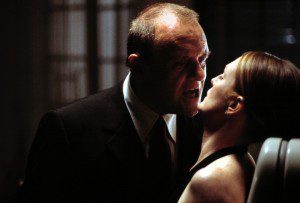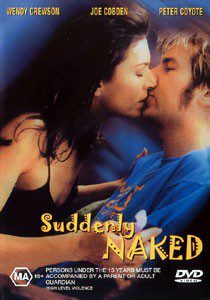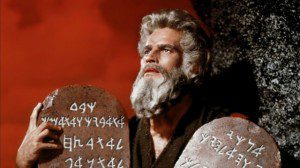 It’s been almost ten years to the day since The Silence of the Lambs came out, and I still have vivid, terrifying memories of the experience. What lingers with me most is not the sight of rotting corpses with insects tucked inside their mouths and patches of skin carved from their backs, nor Hannibal “The Cannibal” Lecter’s brilliant but grisly escape from prison. Rather, the image seared onto my brain is the ultra-tight close-up on the serial killer’s nipple ring. The first time I saw that film, it had sold out so quickly that the only seat left to me was in the very middle of the very front row. The screen towered I-don’t-know-how-many stories above me, and the sight of a finger twiddling with that bit of jewelry just freaked me out, especially blown up to that size.
It’s been almost ten years to the day since The Silence of the Lambs came out, and I still have vivid, terrifying memories of the experience. What lingers with me most is not the sight of rotting corpses with insects tucked inside their mouths and patches of skin carved from their backs, nor Hannibal “The Cannibal” Lecter’s brilliant but grisly escape from prison. Rather, the image seared onto my brain is the ultra-tight close-up on the serial killer’s nipple ring. The first time I saw that film, it had sold out so quickly that the only seat left to me was in the very middle of the very front row. The screen towered I-don’t-know-how-many stories above me, and the sight of a finger twiddling with that bit of jewelry just freaked me out, especially blown up to that size.
The body piercing was just one detail, of course, in a much larger portrait of a psychopath who lived, shall we say, on the wrong side of the tracks. By comparison, Hannibal Lecter, as performed by Anthony Hopkins, was the very embodiment of class and refined taste — provided, of course, that one overlooked the fact that he also had a taste for human tissue. Thus it is that the movie Hannibal, the long-awaited sequel to Silence of the Lambs that moves its titular flesh-eater to centre stage, is a film so posh, so exquisite in look and sound, that it would hardly seem like a sequel at all if it weren’t for the return of Hopkins to the role that made him famous. Goodbye, subterranean rock and roll; hello, opera.
As the film begins, Hannibal is living in Florence, Italy and is about to take on a job as head of an art gallery, replacing the previous curator, who died under mysterious circumstances. Inspector Pazzi (Giancarlo Giannini), the officer inspecting the death, comes to suspect foul play, especially when he sees Hannibal’s face on the FBI’s “ten most wanted” web site. Instead of turning him over to the authorities, though, Pazzi tries to claim the reward money offered by Mason Verger (an uncredited, and unrecognizable, Gary Oldman), a disfigured millionaire who, as Lecter’s only surviving victim, has revenge plans of his own in mind.
Meanwhile, former FBI cadet Clarice Starling (Julianne Moore, filling in for Jodie Foster) is a ten-year veteran of the Bureau who still has to put up with the sexism of her colleagues, and whose career is jeapordized when a drug bust goes bad. (The gunfight and its aftermath are reminiscent of the battle sequence that opened Gladiator, which, like Hannibal, was also directed by Ridley Scott — lots of chaotic action followed by slow-motion photography and mournful music.) Clarice is given the job of tracking Hannibal down, and it isn’t until the film’s final act that they finally meet again, in person, without barriers between them, for the first time.
Until that point comes, Hannibal and Clarice must move about in their own exclusive spheres, he in Italy and she in the United States, and the relationship between them exists more in our memories of the last film than it does on the screen. The script, adapted by David Mamet and Steve Zaillian from Ted Harris’s novel, is generally faithful to the book, but it doesn’t have the urgency of the previous film. The story is too loose, and while the film’s chilling concluding moments are bound to be the subject of water cooler chitchat for, oh, at least a week, there’s not much of a payoff there. Perhaps it’s because there’s nothing really at stake here, and no one whose life we care to save.
Moore acquits herself well enough in the role that Foster nailed so definitively a decade ago, but the character has been reduced to a foil for Hannibal, who surrounds himself with the trappings of the upper class, even, if not especially, when he’s dispatching one of his victims. In the last film, Hannibal stole the show; in this film, the producers have built it around him. Two murders stand out in particular; we are prepared for one by Hannibal’s professorial speeches on violence in art and history, while the other is presented as a sort of gourmet vivisection by candlelight. Nothing in this film made me squirm like the nipple-ring in the last film, but still, Hannibal ain’t for the squeamish.
3 stars out of 5
— A version of this review was first published in the Vancouver Courier.












